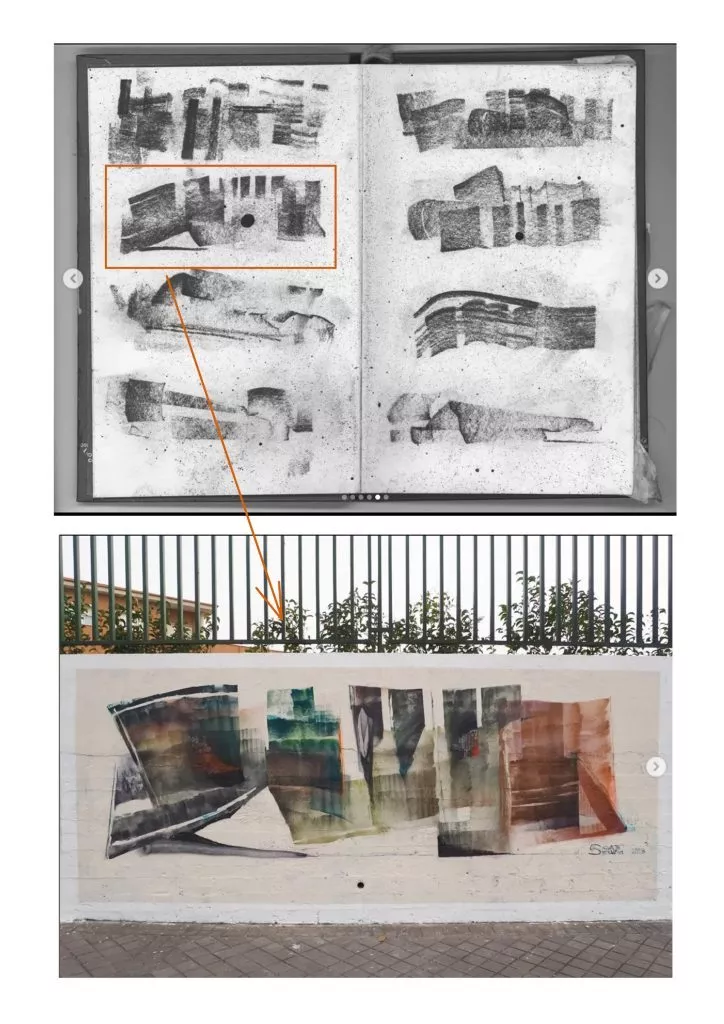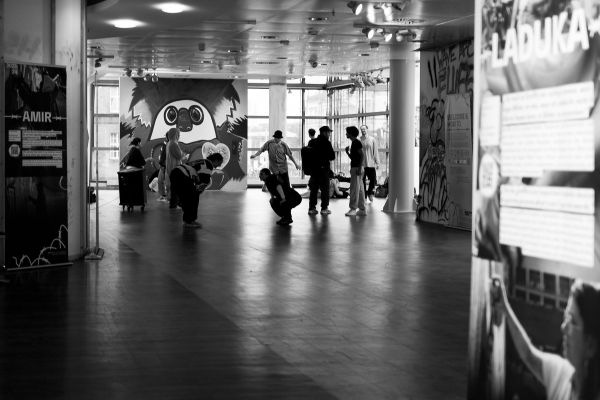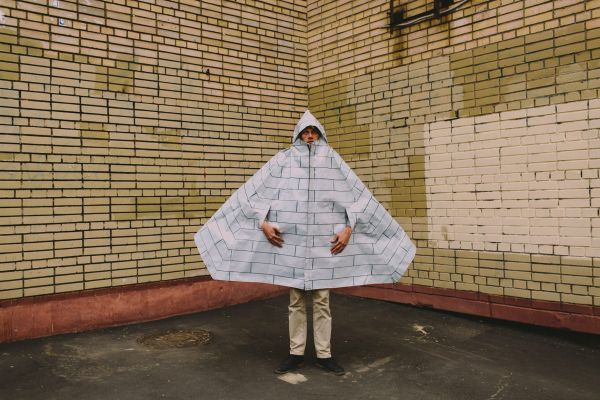Salvaje Selva in Spain: Expressive abstraction with engraving techniques on walls
First contact with art through the family
Salvaje Selva was born in 1993 in Yecla, a town in the North of Murcia, and grew up in the city of Murcia. During his childhood, he enjoyed watching animation and started drawing regularly. His father liked painting like his grandfather and his mother was into history of art. They had many books on Impressionism and Post-Impressionism, and Selva looked at them over and over again. Paintings by Munch, Van Gogh, Kirchner and Goya made a lasting impression on him. His grandfather managed the cultural centre in his town, handling painting exhibitions and collecting works of art, including paintings by an imitator of El Greco with this particular dynamic brushstrokes, Selva remembers today. A brother-in-law of his mother was a comic book artist, specialized in political satire. Selva spent some summers with him in the countryside, watching him paint with watercolours or drawing. At the same time, his close cousin started doing graffiti when he was 11 and taught Selva everything he knew about style writing. And in his city Murcia Graffiti was already in the streets, on highways, in tunnels. Those strange forms that looked like letters sparked Selva’s curiosity. It was in the early 2000s, and he remembers that he saw already murals with stretched letters, often in three dimensions, with characters, many elements, complex and unusual for that time.










Starting to style write, observing the scene, being part of crews
When Selva was about 11 years old, he started to sketch letters, trying to create pieces in his drawing sessions. On the walls of his family’s summer house, Selva could start to experiment with spray cans he got. He explored the surroundings of this house, its ruins on the edge of the mountain, a tunnel, and more old walls that he found in the fields. Using leftover house paint from the construction as well, he painted many pieces, enjoying the time alone in abandoned places. Later, in high school, he formed a crew, taught friends how to paint letters, and started meeting other writers in the city who, despite being his age, already had a name in the local scene. Selva adopted different artistic nicknames, such asBRUJO, later in 2010 using JUNGLE. In 2013, he started writing the Spanish version SELVA, preferring the letters and phonetics.
Being interested in the local scene, Selva observed the works by other graffiti writers since the beginning. One of his favourite writers of his town was Saezoner/Opio. In the early 2000s, he painted already pieces featuring weird experimental backgrounds and characters. Some massive pieces showed baroque typography full of details, giant stencils, and artistic bombings. He also organized collective mural productions with his group 543doom, combining realism, comic art, cubism, graffiti, and all styles. Another significant writer was Jhoez98, with whom Selva later shared a crew. His style was also highly experimental. In his city, since the time of the first crew ZNP (originally based on the precepts of the Zulu Nation), there was a culture of creating large collective murals, conveying a message or idea. Many halls of fame scattered throughout the city, where it was common to find character paintings as well. Selva often watched the more experienced artists paint and learned a lot only by observing. But another source for getting knowledge was the internet and publications like fanzines where he discovered classics of graffiti like by Swet, Reso, Dare, Cantwo, Bates and Mode2. Aware of the work by many different writers, local and international, Selva describes himself being like a sponge at the time, soaking up every visual language. Much later, he discovered Graffuturism and the French post-graffiti scene. Yann Loutsider is one of his favourite artists, as well as Bims and Vunik for their particular textures. His Spanish artist friends Emilio Cerezo and Laguna, with whom he still collaborates regularly are another big source of inspiration, being masters in his eyes.
Over the years, Selva was active in many crews. His first crew was UKM at high school. In 2011, he became part of his cousin’s crew called CERO COMERCIO. Later, he joined one of the most powerful groups in his city: 450. Led by Jhoez, including Niger, Romeo, Waker, Ceors, Dasen and Silent, the crew transformed later with Cero Comercio into 450COPS (450 + 0 COMERCIO POSSE). But Salves most important crew is QATRS. He founded it with his closest friends: Kako, Chose, Penas, Risk, Remo, Niger, Blues, Poncho, Trayan, and Lucas. In Madrid, where Selva moved in 2015, he met new friends and created the PETRONZA group with DMS1, Sonek, and Juanito Ilógico. He was part of La Cofradia as well, with Sea, Miek, Gerbos, and DMS1, and entered the Keller collective with other urban artists such as NSN997, RBN, Kerú de Kolorz, Will Yacome, Savelga, Gerbos, Porfavorhh. In circa 20 years, Selva has been active in many crews and collectives. For him, a huge part of the magic of graffiti lies in the friendships and bonds that are created through it.








Fine Art studies with specialization in engraving
In 2009, Selva decides to do an art bachelor at another high school, the IES Floridablanca. There, he got the permission to paint murals within the school itself. In 2011, after two years, he finally entered university in Murcia and studied Fine Arts. He remembers that there he had to practice other art disciplines like performance, installation, or video art that he didn’t like, he just wanted to draw and paint. In 2013, he had a car accident and received a financial compensation, which helped him to do an Erasmus program in the last year of his degree. He went to Naples, Italy in 2014 and spent a year specializing in engraving and printing. As soon as he arrived, he went to paint graffiti and met Giovanni Timpani “Zonk” who turned out to be the technician in the engraving workshop at the Academy of Art. When he returned to Spain, he wanted to continue studying engraving and considered doing a master’s at the Casa de la Moneda in Madrid in 2015. It was one of the few engraving master’s programs at the national level, and Selva could continue two more years of training and learning about drawing and engraving techniques. Since then, Selva lives in Madrid. According to him, engraving taught him a lot about layering and ways to generate volume, delicate textures, deep colours like inks, and large tonal scales through glazes.

















Organic expressive abstract painting on walls
In the first 10 years of his graffiti practice, Selva painted mainly wild style letters and characters, combining both in experimental ways, evolving into more complex, painterly expressive works with particular dynamics. Around 2017, after realizing that lettering and figuration wasn’t as an inspiration to him any more and his interests and sensibility became more focused on strokes and textures, Selva developed his particular abstract visual language. In the early years practising abstraction, his shapes like coloured flames were expressive and expansive, impulsive and spontaneous, the gesture and dynamics were in the centre of attention. In the last six years, his abstract work became more constructed, more complex and multilayered with original and outstanding techniques. For this, Selva didn’t follow a certain method, but some principles. He believes that in painting, it is about how to combine feeling and strategy. Freedom is crucial, but the artist should know how to organize working steps and painting layers intelligently. Depending on the work, Selva makes a certain plan. But his work methodologies vary, because in his eyes each piece, each painting, is an own world. He tries to be flexible and adapt in situ, to keep a flow for each work in the space. In the end, he says, it is about posing a problem and finding the best solution for a painting in its environment. And finally, Selva improvises most of the time for his non-commissioned wall paintings during the process, because to him this freedom is crucial, for the creative process and for taking risks. Because in the end, what is important is not how a piece starts, but how it finishes, he says, and one must be sensitive to the process, engaging a dialogue with the paint itself.














Developing special techniques for his own language of painting
The techniques used by Selva varied over the years, but his main instrument remains the spray paint. He learned how to control many effects and types of lines, gradients, graininess, tube strokes. However, for the past few years, he has been working with mixed media and incorporated acrylic paint into his repertoire for different reasons. His need to explore and try new things out, let him work on his colour palette with acrylic, mixes it while it’s wet, creates impastos and textures with relief, does glazes and washes, uses roller and brush for gestural work. Currently, he combines the imprint of large rollers with the work of high-pressure spray cans like MadMaxxx or Ultrawide. The idea behind is to be able to tackle larger formats without the gestures becoming small or anecdotal. Being a fan of Astro Fat caps and Lego caps for their transparent strokes that open and close, he uses those as well for creating tubes that he applies to create patterns. Often using transversals, he likes their ethereal gradients achieved by tilting the spray to degrade to one side.
Starting with a light background and using tape or paper, he creates reserves to preserve the background, adding layers of effects in a medium colour, later with a darker one. After removing the reserves, he figures out how to adjust details to make everything work. Sometimes he uses watery acrylic stains across the entire surface and builds gaps and margins. Wet solutions allow him to preserve the gesture of a brushstroke, for example. For this, he uses soap or mud, things that can cover areas and can be removed with water afterward. For his original delicate transparencies, he employs for example wide nozzles, applying carefully gradients and semi-transparent strokes, working in layers like an engraver. Concerning the choice of colours, the artist works intuitively. Sometimes he tests and uses unusual tones to force himself to make them work. Selva believes that colour is not just about combination, but also about proportion. The same palette can work or not, depending on the quantities of each colour. And Selva developed special colour combinations, layers of transparent tones, vibrating chromatics that he applies carefully with accuracy and vibrancy and dynamism at the same time.
The visible application, the gesture plays a decisive role in his work like in lyrical abstraction, another source of inspiration for Selva. Many times, he risks everything with a single stroke, because the most beautiful aspect of painting is a good gesture in his eyes. Many pieces are constructed purely from effects and a la prima strokes. That’s why he often refers to „constructions” for his pieces that gradually build up. Sometimes he defines a frame on the wall to highlight the architecture and for integrating the piece into it, giving it sobriety. It also helps to generate contrast that highlights the value of the different textures, he says. In his latest works the influence of collage, gestural painting, or lyrical and organic abstraction is very present. Being passionate about Baroque painting, especially Flemish Baroque, Selva created several pieces, more or less abstract, inspired by the Baroque, like a series inspired by Rubens. Consequently, homages to classical painting are part of his discourse, based on understanding painting as a universal language that traverses different eras while maintaining common elements. The old expressionists used to say that the ‘object’ is an excuse for the artist to project their particular way of doing, and Selva deeply believes this approach. He sees painting as an end in itself and seeks to express himself through its abstract values. Beauty lies in the language of painting itself, and Selva explores and searches for images that have that magic of expressing where words fail.
























Working in the studio versus outdoor
Sketching is a very important part for Selva since the beginning. Even if he sketches without high expectations, they are a very important part of his visual research in the studio: studies of gesture, composition, colour, texture. Sometimes he starts with small sketches, using gestures with graphite or charcoal bars to explore compositions. Photographs he takes gives him ideas for colours or shapes as well. On occasions, for commissioned projects, he makes a sketch to copy it later (with changes during the process). His studio practice is part of his artistic exploration and influences his large-scale wallpaintings as well. The main difference is the absence of context, he says. When creating a wall painting, you’re engaging with the environment. Working outdoors, you are exposed to the elements, it’s much more physical and ephemeral, so it’s best to finish in a day and take photos with good light (your piece might not exist or might be destroyed when you return). In the studio, you don’t have that problem. There Selva works with spray paint, pastel, charcoal on paper, creates monotypes and prints with the press, or paints with spray paint, acrylic or oil on canvas. Sometimes he creates for himself, other times he works on commissions for a specific project with particular conditions. Generally, he prefers working on small formats in the studio, taking less space.








But besides this lonely work in the studio, collaborations outdoor are still very important Salve. He frequently teams up with friends to create something together. And nowadays in the post-graffiti scene, collaborations involve merging, painting partly over another artist’s work, and having them paint over yours as well. For Selva, it’s like adding another ingredient to the recipe – it creates more excitement and helps you to put your ego aside. The great things that can arise from teamwork are those possibilities you discover, that you will never know working on your own. Many times, there are pieces that remain unfinished over years. In July 2022, Selva painted with Laguna for three days, and they ended up creating 30 collaborative pieces. According to Selva, working in a team resets your system: after those encounters, you see painting with a fresh eye – you have to face a challenge and use all your tricks. After that, you feel the need to reconsider your own ways of doing things and to invent new ways for the future.
The practice of graffiti has had a significant influence on Selva’s artistic evolution and continues to do so. His interest in graffiti somehow intersected with his broader interest in art, but the essence of graffiti, its free and expressive spirit, has permeated his work, influenced his artistic approach in terms of composition, colour use, and experimentation with different styles and techniques. And besides his studio practice, Salvaje Selva still continues to paint in abandoned places, because he believes there can emerge the purest form of painting, where a painter can find the greatest freedom. Those painting sessions and final photos of the wallpaintings in situ are priceless in his eyes.













239 views
Categories
Tags:





Leave a Reply